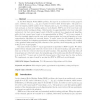Free Online Productivity Tools
i2Speak
i2Symbol
i2OCR
iTex2Img
iWeb2Print
iWeb2Shot
i2Type
iPdf2Split
iPdf2Merge
i2Bopomofo
i2Arabic
i2Style
i2Image
i2PDF
iLatex2Rtf
Sci2ools
APPROX
2015
Springer
2015
Springer
On Approximating Node-Disjoint Paths in Grids
In the Node-Disjoint Paths (NDP) problem, the input is an undirected n-vertex graph G, and a collection {(s1, t1), . . . , (sk, tk)} of pairs of vertices called demand pairs. The goal is to route the largest possible number of the demand pairs (si, ti), by selecting a path connecting each such pair, so that the resulting paths are node-disjoint. NDP is one of the most basic and extensively studied routing problems. Unfortunately, its approximability is far from being wellunderstood: the best current upper bound of O( √ n) is achieved via a simple greedy algorithm, while the best current lower bound on its approximability is Ω(log1/2−δ n) for any constant δ. Even for seemingly simpler special cases, such as planar graphs, and even grid graphs, no better approximation algorithms are currently known. A major reason for this impasse is that the standard technique for designing approximation algorithms for routing problems is LP-rounding of the standard multicommodity flow relaxat...
Related Content
| Added | 16 Apr 2016 |
| Updated | 16 Apr 2016 |
| Type | Journal |
| Year | 2015 |
| Where | APPROX |
| Authors | Julia Chuzhoy, David H. K. Kim |
Comments (0)

